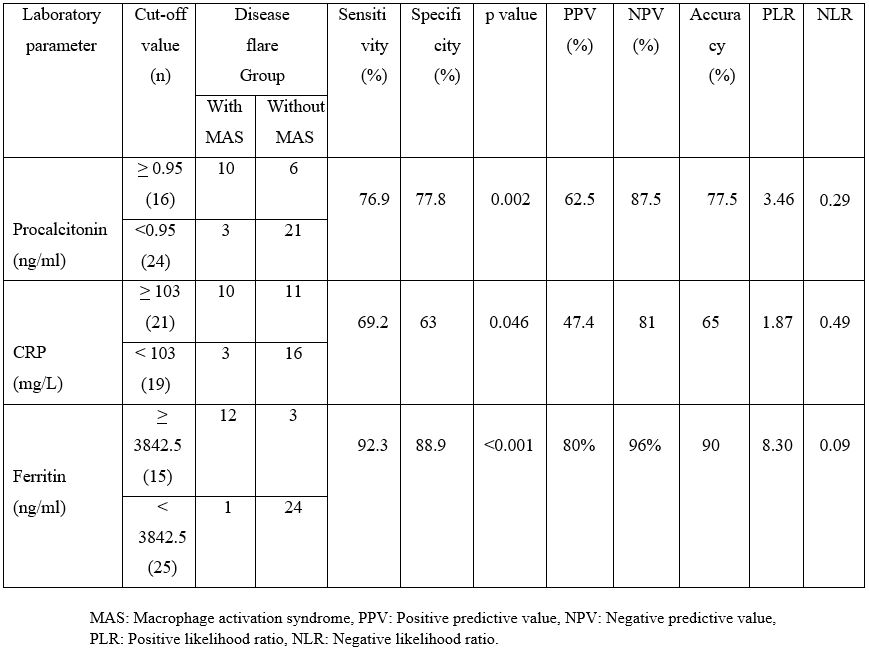Session Information
Session Type: Poster Session A
Session Time: 8:30AM-10:30AM
Background/Purpose: Fever is the most common presentation of systemic juvenile idiopathic arthritis (SJIA) and it is difficult to predict whether the fever is due to infection or underlying disease flare. This study has been undertaken to determine the role of clinical and laboratory parameters in differentiating infection and disease flare in febrile patients of SJIA, with particular reference to serum procalcitonin levels.
Methods: In this cross-sectional study, patients diagnosed with SJIA (as per ILAR classification criteria) who presented with fever (temperature ≥38oC) for more than ≥48 hours under the age of 16years between March 2018 to October 2019 were included. Blood samples for hemogram, acute phase reactants (ESR, C- Reactive protein and ferritin) procalcitonin levels were collected along with cultures of the respective body fluids at the time of presentation for the evaluation of fever. Patients were stratified into infection group and disease flare (with or without MAS) group. Febrile episodes were categorized as “Infection” based on their clinical profile along with body fluid evaluation & culture or tissue culture or serological assays or any imaging study suggestive of infection and their prompt response to antibiotics without hiking the immunosuppression. “Disease flare” group was defined as those patients with daily fever ≥38oC for ≥2 days in a diagnosed case of SJIA, without any laboratory evidence of infection and the prompt response to hike in immunosuppression. MAS was defined as per the EULAR/ACR 2016 classification criteria. The receiver operating characteristic (ROC) curve analysis was used to find out the respective cut-off values.
Results: A total of 52 visits of 25 patients were included. Twelve (23.1%) were in the infection group and 40 (76.9%) were in the disease flare group (27 were disease flare without MAS and 13 were disease flare with MAS). The mean (SD) & median (IQR) values of laboratory parameters including serum procalcitonin levels did not show any statistical significance in differentiating infection and disease flare groups, whereas clinical parameters like quotidian pattern of fever, evanescent maculopapular rash and joint symptoms showed statistical significance (p value: < 0.05). In patients with disease flare, cut-off values of procalcitonin ≥0.95ng/ml, CRP ≥103mg/L and ferritin ≥ 3842.5 ng/ml predicted MAS with good sensitivity and specificity (p value:< 0.05).
Conclusion: In our study none of the laboratory parameters including serum procalcitonin levels, were useful in differentiating infectious cause of fever from disease flare in febrile patients with SJIA. Serum procalcitonin levels were elevated even in the absence of infection in SJIA disease flare with MAS and a value of ≥0.95ng/ml was found to be a reliable predictor in identifying the MAS complicating SJIA. Presence of classical clinical features of SJIA are helpful in differentiating the disease flare from infection with high accuracy.
To cite this abstract in AMA style:
Kanumuri R, Balan S, Marwaha V, Krishnan S, Chickermane P. Role of Clinical and Laboratory Parameters in Differentiating Infection from Disease Flare in Febrile Patients of Systemic Juvenile Idiopathic Arthritis [abstract]. Arthritis Rheumatol. 2021; 73 (suppl 9). https://acrabstracts.org/abstract/role-of-clinical-and-laboratory-parameters-in-differentiating-infection-from-disease-flare-in-febrile-patients-of-systemic-juvenile-idiopathic-arthritis/. Accessed .« Back to ACR Convergence 2021
ACR Meeting Abstracts - https://acrabstracts.org/abstract/role-of-clinical-and-laboratory-parameters-in-differentiating-infection-from-disease-flare-in-febrile-patients-of-systemic-juvenile-idiopathic-arthritis/



